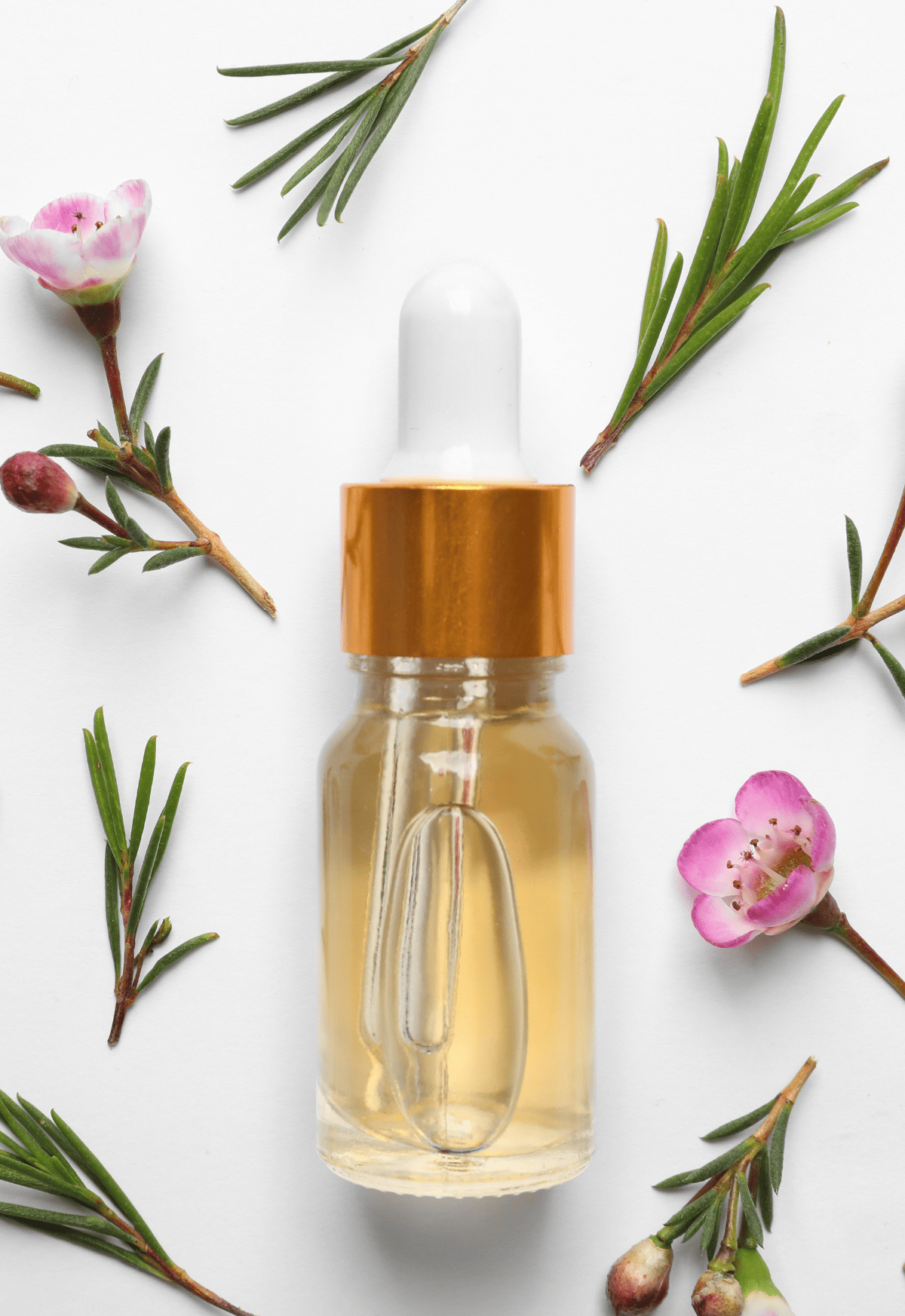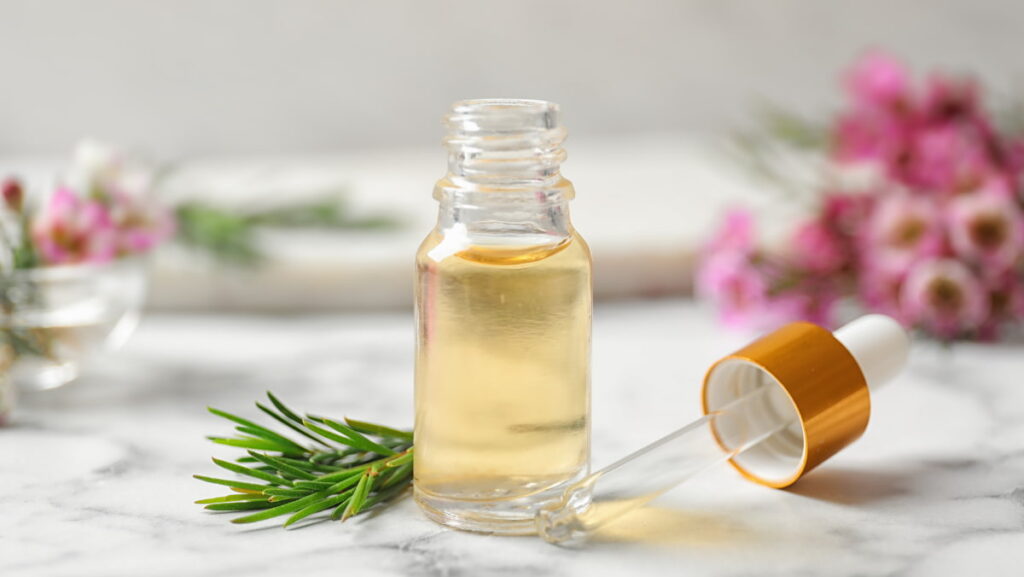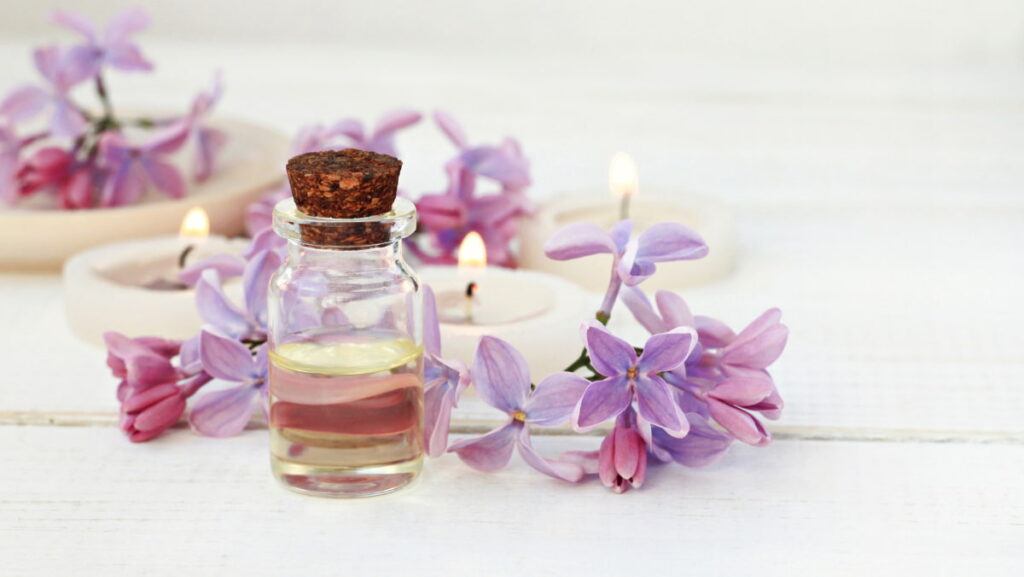
Struggling with skin problems can be frustrating, and finding products suiting your unique skin care needs can be even more nerve-racking.
However, one natural remedy has been turning heads for its unique properties: tea tree oil.
It is known for its powerful antiseptic properties and is celebrated for being an effective solution for various skin issues.
I will dive deep into this natural wonder to make your first acquaintance with the incredible benefits of tea tree oil on the skin.
From common problems like acne to fungal infections, tea tree oil has an impressive portfolio for supporting skin health.
Its antimicrobial and anti-inflammatory properties make it an excellent choice for combating breakouts, soothing irritated skin, and even smoothing your complexion.
You’ll find that incorporating this essential oil into your routine can offer long-lasting improvements to your skin’s appearance and overall health.
Are you intrigued to discover the numerous benefits of tea tree oil on the skin? Welcome! Read on to learn more about what this incredible natural remedy can do for your skin.
What Is Tea Tree Oil
Tea tree oil is a remarkable elixir straight from nature’s medicine cabinet! It is produced by steam distillation of the leaves and final branches of the tea tree oil, native to Australia.
I don’t know if that sounds amazing, but the benefits of tea tree oil on the skin are!
So, how does tea tree oil work its magic? It comes down to a compound called terpinene-4-ol, which is responsible for this oil’s incredible antibacterial and antifungal abilities.
Recently more skin-loving ingredients have received recognition for their antioxidant properties, such as a-terpinene, a-terpinolene, and c-terpinene.
6 The Benefits Of Tea Tree Oil On The Skin

Tea Tree Oil Is A Powerful Antioxidant
When it comes to the well-being of our skin, antioxidants play a pivotal role in safeguarding it against the harmful effects of free radicals.
These unstable molecules can cause significant damage, leading to premature aging and other skin concerns. That’s where tea tree oil comes to the rescue.
Recent studies have shed light on the primary contributors to its antioxidant prowess: three terpenic compounds known as R-terpinene, R-terpinolene, and γ-terpinene.
It’s worth noting that these compounds make tea tree oil comparable to synthetic antioxidants like butylated hydroxytoluene (BHT).
Tea Tree Oil Is A (Kill-It-All) Antiseptic
Tea tree oil is rich in antioxidants and possesses remarkable antiseptic properties. Its star component, terpinen-4-ol, is a true warrior against bacteria, including the stubborn antibiotic-resistant.
These properties contribute to combating acne-causing bacteria, helping to keep your skin clear and blemish-free. Additionally, its antifungal properties can help alleviate athlete’s foot, ringworm, and other fungal infections.
Tea Tree Oil Is A Great Acne Remedy
If you’ve struggled with acne, you’re probably familiar with the quest for an effective treatment. Tea tree oil has gained recognition for its ability to combat acne due to its broad-spectrum antimicrobial and anti-inflammatory properties.
The oil has been extensively used as a topical treatment to control acne-causing bacteria. Studies have shown the efficacy of 5% tea tree oil gel in treating acne vulgaris, with results comparable to those of 5% benzoyl peroxide lotion.
Tea tree oil reduces closed and open comedones and shows promising results in improving acne symptoms over time.
How does tea tree oil benefit acne-prone skin?
- It reduces inflammation and redness.
- Tea tree oil unclogs pores, preventing further breakouts
- It speeds up the healing process
- It serves as a natural alternative to harsh chemicals found in acne treatments.
Tea Tree Oil Contributes In Wound Healing
Tea tree oil’s healing properties extend beyond acne treatment. Among the incredible benefits of tea tree oil on the skin lies Its ability to promote wound healing, making it a valuable natural remedy.
Research suggests that Tea Tree Oil can enhance healing by reducing inflammation, promoting collagen synthesis, and preventing microbial infections.
When applied to minor cuts, scrapes, and burns, tea tree oil aids in the growth of new, healthy skin cells, facilitating the healing process.
Tea Tree Oil Helps Tackle Numerous Skin Concerns
Besides its benefits in treating acne and wound healing, tea tree oil offers various advantages for various skin concerns.
Its antibacterial and antifungal properties are effective against dry skin, eczema, and fungal infections. Tea tree oil can also help reduce allergic wheal and flare, relieving discomfort.
Tea Tree Oil Is Promoting Hair Health
Tea tree oil can be a valuable ally for those dealing with scalp issues like dandruff. One of the excellent benefits of tea tree oil on the skin is that it combats dandruff. It also relieves scalp itchiness and inflammation, promoting a healthier scalp and hair.
Mix a few drops of tea tree oil into your favorite shampoo to keep your scalp and hair healthy.
Potential Tea Tree Oil Side Effect
According to this comprehensive review, tea tree oil is generally considered safe when used topically on the skin. However, it can cause specific side effects in some individuals.
Here are some potential side effects of tea tree oil on the skin:
- Skin irritation: Tea tree oil is a potent essential oil, and some people may experience skin irritation or allergic reactions when applying it directly to the skin. Symptoms may include redness, itching, burning, or a rash.
- Dryness and peeling: Tea tree oil may cause dryness or peeling of the skin, especially when used in high concentrations or by individuals with sensitive skin.
Pro tip: It is advisable to dilute tea tree oil with carrier oil (such as coconut or almond oil) before applying it to the skin.
- Contact dermatitis: In rare cases, tea tree oil can cause contact dermatitis, an inflammation of the skin resulting from direct contact with an irritant or allergen. Signs of contact dermatitis include redness, swelling, itching, and blistering.
- Allergic reactions: Some individuals may be allergic to tea tree oil; in such cases, even small amounts can trigger an allergic reaction.
Symptoms of an allergic reaction may include hives, itching, swelling, difficulty breathing, or a rash. If you experience these symptoms after using tea tree oil, discontinue use and seek medical attention.
- Eye irritation: Tea tree oil should be kept away from the eyes as it can cause irritation, redness, and stinging. If accidental contact occurs, rinse the eyes thoroughly with water.
According to the review listed above, skin irritation can be avoided by using lower concentrations of tea tree oil.
Also, it suggests that allergic reactions are mostly due to oxidation products that occur in aged or improperly stored oil.
Therefore, proper dilution and storage of the essential oil can make a huge difference in the way your skin reacts to it!
Does Tea Tree Oil Clog Pores?
I am most excited to announce that tea tree oil is generally considered non-comedogenic, which means it does not clog pores.
In fact, it is often used in skincare products targeting acne and oily skin due to its potent antibacterial and anti-inflammatory properties.
So, if you have acne-prone skin, you do not have to shy away from trying the amazing benefits of tea tree oil on the skin.
Common ingredients in skincare products are rated on a scale of 0–5. The higher the number is, the higher the chances are that your pores may get clogged.
Generally, values of 2 and below are unlikely to cause clogged pores. So products containing ingredients with these scores are considered non-comedogenic.
The comedogenic scale ranges from 0-5 and looks like this:
- 0: Does not clog pores
- 1: Low chance of clogging pores
- 2: Moderately low chance of clogging pores
- 3: Moderate chance of clogging pores
- 4: Relatively high chance of clogging pores
- 5: High chance of clogging pores
Tea tree oil is rated a 0. This means it does not clog pores and is considered non-comedogenic.
However, individual reactions to any substance can vary, and while tea tree oil is unlikely to clog pores for most people, there is a small possibility that it could cause clogged pores or breakouts in some individuals.

How To Use Tea Tree Oil
Balancing the benefits of tea tree oil on the skin and the potential irritation it can cause is a craft. Tea tree oil is a potent essential oil and should, therefore, be handled properly.
When using tea tree oil on the face, it’s important to follow proper guidelines to ensure safe and effective usage. Here are some foolproof tips on how to use tea tree oil on the face:
- Dilute The Tea Tree Oil
Tea tree oil is highly concentrated and can be too strong for direct application to the face. Dilute it by mixing a few drops of tea tree oil with a carrier oil, such as coconut oil, jojoba oil, or almond oil.
The recommended ratio is about 1-2 drops of tea tree oil per 1 tablespoon of carrier oil. This helps to reduce the risk of skin irritation.
- Perform A Patch Test
Before applying the diluted tea tree oil to your entire face, it’s advisable to do a patch test. Apply a small amount of the diluted mixture to the inside of your forearm or behind your ear.
Leave it on for 24 hours and observe for any adverse reactions such as redness, itching, or irritation. If there are no negative reactions, you can proceed to the next step.
- Use For Spot Treatment
Apply the diluted tea tree oil on individual blemishes rather than your entire face. Use a cotton swab to avoid spreading bacteria. Avoid getting the oil mixture too close to your eyes.
- Use Tea Tree Oil On Clean Face
To maximize its absorption and avoid the reaction with other skincare ingredients, apply your tea tree oil on a clean face.
Use a gentle facial cleanser suitable for your skin type to remove any dirt, oil, or makeup, and pat your face dry with a clean towel.
- Follow Up With Moisturizer
Leave the tea tree oil mixture on your face to allow it to absorb into the skin. Usually, the carrier oil you use for dilution contributes to the moisture.
However, you can follow up with your regular moisturizer to provide additional hydration and help prevent any potential dryness.
- Be Consistent
Tea tree oil can be used once or twice a day, depending on your skin’s tolerance. Start with less frequent applications and gradually increase if your skin responds well.
I would recommend that you use tea tree oil as a spot treatment rather than applying it to the entire face.
- Discontinue Use If Necessary
If you experience any persistent irritation, redness, or other adverse reactions, discontinue using tea tree oil on your face and consult a dermatologist for further guidance.
Pro tip: Everyone’s skin is unique, and paying attention to your skin’s response is essential. If you have any specific concerns or underlying skin conditions, it’s always a good idea to consult a dermatologist before incorporating tea tree oil into your skincare routine.
Ideas On How To Use Tea Tree Oil
- Create a DIY tea tree oil spray to help relieve itching from bug bites or skin allergies by mixing tea tree oil, water, and apple cider vinegar.
- Add a few drops of the oil to your regular skincare products, such as lotions or creams, to enhance their benefits and promote healthier skin.
- Make a soothing compress by combining tea tree oil with warm water, then soaking a clean cloth in the mixture and applying it to the irritated area.
Can You Put Tea Tree Oil Directly On Your Skin?
Putting undiluted tea tree oil directly on your skin is generally not recommended, especially if you have sensitive skin. Tea tree oil is highly concentrated and can cause skin irritation, redness, and even allergic reactions when undiluted.
To safely use tea tree oil on your skin, it is important to dilute it with a carrier oil before applying it. Carrier oils like coconut oil, jojoba oil, or almond oil help to dilute the tea tree oil and reduce its potency, making it safer for direct application on the skin.
The recommended dilution ratio is typically around 1-2 drops of tea tree oil per 1 tablespoon of carrier oil. This ratio can be adjusted based on your skin’s sensitivity and tolerance.
By diluting tea tree oil, you can still benefit from its potential antibacterial and anti-inflammatory properties while minimizing the risk of skin irritation.

Does Tea Tree Oil Expire?
Yes, tea tree oil can expire, but it generally has a long shelf life if stored properly. The shelf life of tea tree oil can vary depending on various factors, including the brand, quality, and storage conditions.
Tea tree oil typically has a shelf life of about 2 to 3 years from the production date when unopened. However, once opened, the shelf life can be shorter, usually around six months to 1 year, as exposure to air and light can gradually degrade the oil.
To ensure the longevity of tea tree oil, it is important to store it properly. Here are some foolproof tactics to keep your tea tree oil fresh longer:
- Keep it in a cool, dark place: Store tea tree oil in a cool, dark area away from direct sunlight and heat. Excessive heat and light exposure can accelerate the breakdown of the oil.
- Use a tightly sealed container: Ensure that the bottle or container is tightly sealed to prevent air from entering, which can contribute to oxidation and degradation of the oil.
- Avoid contamination: When using tea tree oil, be cautious not to contaminate the bottle or container with water, dirt, or other substances that can introduce impurities and potentially shorten its shelf life.
Sniff test your oils regularly. If they develop an off smell, appear discolored, or show any signs of spoilage, it is best to discard them and grab a fresh bottle.
I can also not stress enough how important it is to go for high-quality essential oils. Give a bit of extra money for a tea tree oil of good quality that ensures your skin’s safety.
Best Tea Tree Oil Skincare Products
- Dr.Jart+ Teatreement Moisturiser: This lightweight moisturizer harnesses the power of tea tree oil to calm and clarify the skin. It helps to balance oil production, reduce blemishes, and promote a clearer complexion, leaving your skin hydrated and nourished.
- The Body Shop Tea Tree Oil: Known for its purifying properties, this iconic tea tree oil helps to target blemishes and imperfections. Its antiseptic and antibacterial qualities make it ideal for spot treatments and promoting a healthier-looking complexion.
- Dermalogica Acne Clearing Skin Wash: Formulated with tea tree oil and salicylic acid, this refreshing skin wash effectively clears breakouts and prevents future blemishes. It gently exfoliates the skin, unclogs pores, and soothes inflammation, leaving your skin feeling clean and renewed.
- ESPA Purifying Tea Tree Gel: This lightweight gel harnesses the natural antibacterial properties of tea tree oil to control excess oil, calm redness, and promote a clearer complexion. It helps to minimize the appearance of blemishes while leaving your skin feeling refreshed and revitalized.
- I Dew Care Roll With Tea Tree Roll-On Face Oil: This convenient roll-on face oil combines the soothing properties of tea tree oil with nourishing botanicals. It helps to calm irritated skin, reduce redness, and promote a healthier-looking complexion, while its portable design makes it perfect for on-the-go application.
- DERMA E Tea Tree & Vitamin E Relief Cream: Enriched with tea tree oil and vitamin E, this relief cream provides intense hydration while soothing and nourishing the skin. It helps to alleviate dryness, redness, and irritation, leaving your skin feeling soft, smooth, and revitalized.
- Tula Keep It Clear Acne Foam Cleanser: Infused with tea tree oil and other skin-loving ingredients, this foam cleanser effectively removes impurities and excess oil without stripping the skin. It helps to prevent breakouts, promote a clearer complexion, and leave your skin feeling clean, refreshed, and balanced.
- Innisfree My Real Squeeze Mask: This sheet mask is infused with tea tree extract to purify and hydrate the skin. It helps to soothe irritated skin, control excess sebum, and improve overall skin texture. After use, your skin will feel refreshed, rejuvenated, and visibly brighter.
Benefits Of Tea Tree Oil On The Skin: A Conclusion
I hope that by now, you agree that the benefits of tea tree oil on the skin are truly remarkable!
This natural superhero offers a range of advantages for various skin concerns. Tea tree oil is the latest skincare obsession, from combating acne and soothing irritated skin to promoting wound healing and supporting overall skin health.
So, why not embark on a skincare journey with tea tree oil? Embrace its natural wonders, explore its endless possibilities, and discover the incredible benefits it can bring to your skin. Get ready to unlock radiant and healthier skin with the power of tea tree oil!
Frequently Asked Questions
